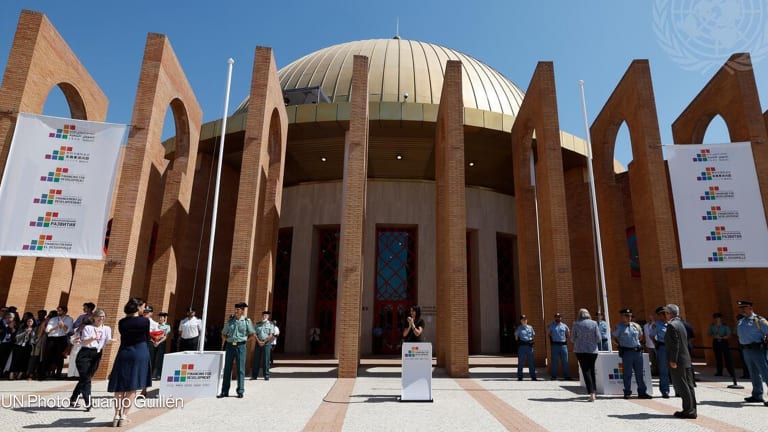
Africa’s population is booming. By 2050, it set to double, and Africa will be home to 2.5 billion people, half of which will be under the age of 25. This growing youth population will need education, jobs, and opportunities in order to realize the demographic dividend. For much of the continent, however, the current trends in financing are hugely disappointing. International aid has largely flat-lined, and more and more countries are at risk of debt distress. Domestic revenue mobilization is critical for funding Africa’s future and for it to sustainably leverage additional sources of finance.
Yet new data released by ICTD/UNU-WIDER shows that revenue collected in Africa dropped by 1.1 percent of GDP in 2016 and by the same amount in the world’s least developed countries. This is the second year of decline for both, and for Africa represents the fastest drop since this downward trend began in 2012. Nominal revenues are $36 billion lower than last year.
World leaders gathered this week in New York for the U.N. General Assembly meetings, where the International Monetary Fund announced new costs of what it would take to finance the Sustainable Development Goals by 2030. IMF Managing Director Christine Lagarde said an estimated $520 billion per year (equivalent to 14 percent of GDP) was needed to finance the SDGs for 49 low-income developing countries, recommending that a tax revenue increase of 5 percent of GDP needed to partially meet those costs was “an ambitious but reasonable target.” But this target will be impossible to meet given current trends. While there is a clear need for greater international assistance and cooperation to help turn the tide, we must understand what lies behind this overall drop in revenues.
First, the global decline in commodity prices (the price of oil, natural gas, and other raw material resources) had a universally negative impact on resource exporters globally. Every region saw record low resource revenues in 2016, with the Middle East and North Africa seeing the largest drop of 8.5 percent of GDP. The 16 African countries that report resource revenues in 2016 saw them decline by one-third, to 3.3 percent of GDP — half of what they were just two years previous and one-fifth of the 13.4 percent recorded a decade ago. The price of commodities, including natural resources, are notoriously unpredictable, and countries must diversify their tax bases in order to achieve long-term growth.
We must also look at tax revenue. Simply put, tax can be broken into direct and indirect sources. Direct taxes are the most stable and predictable type of tax and include taxing individuals and companies directly, whereas indirect taxes put levies on consumption, such as VAT or customs duties. Direct taxes are better as they require a more sophisticated tax administration system and should encourage greater citizen-state accountability. The latest data shows that Africa’s direct taxation has continued its steady increase to reach 6.6 percent of GDP — the highest it has ever been.
This is good news, although there are limits to expanding tax bases, particularly in countries where large proportions of the population are extremely poor. Indirect tax saw a very marginal decline (of 0.2 percent of GDP), but still represents almost 12 percent of GDP. Although it varies by country, neither of these tax revenue increases have been able to compensate for the declines in resource revenue experienced across the continent.
In a world where revenues from natural resources are low and unpredictable, increases in tax need to come from fairer and more sustainable sources. There are success stories, such as Uganda’s development of a database of over 100 high net worth individuals, which increased tax revenue from this group by 10 fold in its first year. Zimbabwe has reduced tax fraud by introducing electronic systems, increasing VAT revenue for 40 percent in six months. Nigeria’s Lagos State has had great success in increasing personal income tax, as well as property taxes, through a simple automated system of property valuation. Other countries, such as Senegal, are open to finding more innovative solutions to increasing tax revenue, having hosted a hackathon last year, during which the tech-savvy from Senegal and around the world were invited to find tech solutions to increasing revenues.
Comprehensive studies on what works across African tax systems, however, are few and far between, and collecting and collating tax data is complex and time consuming. The most recent data we have is from 2016.
Yet we are pinning so many of our SDG financing hopes on the availability of domestic resource mobilization for development. Will these piecemeal solutions be enough to fight the tide of reduction in resource revenue and rising populations in need of health care and schooling? We don’t know.
Global policy forums such as the U.N. General Assembly must place more emphasis on the unsexy task of making better use of evidence — new and old — if they are to place a realistic expectation of domestic revenues in the financing for development space. The success of debt, private finance, and aid that the world is investing in the poorest countries depends on it.








